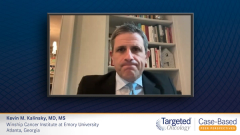
HR+/HER2-low Metastatic Breast Cancer: An Evolving Treatment Armamentarium
Comprehensive insight to the treatment armamentarium for patients with HR+/HER2-low metastatic breast cancer and factors that help inform optimal sequencing.
Episodes in this series

Transcript:
Kevin Kalinsky, MD: There’s lots of discussion about how we should be treating our patients who have metastatic disease who have progressed on hormonal therapy and a CDK4/6 inhibitor. I think we get concerned when we see that the timeline for which they were on their prior CDK4/6 inhibitor and endocrine therapy is less than 6 months, I think for this particular patient, she has lung disease, she is progressing. She was initially symptomatic. Right now, she does not have an alteration of ESR1 or a PIK3CA mutation. This is the sort of patient I would think about giving fulvestrant-based treatment. I would not think about giving fulvestrant alone in this particular patient. We’ve seen from a number of studies, whether it’s EMERALD or MAINTAIN or VERONICA, that single-agent fulvestrant has a short median progression-free survival, often less than 4 months. The control arm in the PACE study was a bit longer than that, but that’s a bit of an outlier.
I would think about giving fulvestrant in combination with another therapy, that could be everolimus, for instance, based upon the PrECOG study. That is an appropriate regimen to consider. There are also data from MAINTAIN, for instance, of patients who had a prior CDK4/6 inhibitor and then giving them a CDK4/6 inhibitor at the time of progression. It’s worth noting in that study, which is just a randomized phase 2 trial, it was not a registration trial, the majority of patients, about 90%, had prior palbociclib and then switched to ribociclib. There were only about 14 patients out of 119 who had ribociclib who went to ribociclib. It’s worth noting that that hazard ratio was the same as what we saw with palbociclib and then ribociclib, but again, it’s a really small population. The MAINTAIN study is addressed in NCCN [National Comprehensive Cancer Network] guidelines, but again, it was not a registration trial. We are awaiting the results of the postMonarch study, which is looking at patients who progressed on an AI [aromatase inhibitor] and CDK4/6 inhibitor, where they received fulvestrant with or without the CDK4/6 inhibitor abemaciclib, and that is a registration trial.
The other thing is, I know I’m saying lots of options here, at San Antonio [Breast Cancer Symposium] in 2022, we saw the results of the CAPItello-291 study, which may lead to the approval of capivasertib in this context. We’ll see whether that drug, which is an AKT inhibitor, is approved regardless of PI3K/Akt pathway alterations. So you can see there are a number of potential agents that are possibilities.
The last thing that I will say is that if this patient did have an ESR1 mutation, one could consider giving single-agent elacestrant, and that is approved based upon the EMERALD study. It is only approved right now as a single agent. One would feel comfortable giving single-agent elacestrant given that the post hoc analyses showed that those patients who had tumors who had been on an AI and CDK4/6 inhibitor for at least 12 months or so really seemed to benefit from elacestrant compared to single-agent physician choice endocrine therapy. So that is an option as well. But long story short, in this particular patient, I would think about giving endocrine therapy-based treatment if she’s not particularly symptomatic, and also given the durability that she had from her prior CDK4/6 inhibitor and endocrine therapy.
I think the features we consider include: how long were they on their prior line of therapy, where is their disease, are they symptomatic, is there impending visceral crisis? And also, the degree of hormone receptor positivity. Those are the sorts of things that have implications in terms of next step options.
Let’s say this patient goes on and receives fulvestrant and everolimus, just for instance, and let’s say this patient is on that for 3 months. And let’s say you check for alterations after that, and the patient does not have an ESR1 mutation or a PIK3CA mutation. There’s nothing that’s targetable. It is also worth noting that it’s important you do germline testing for hereditary syndromes like BRCA or PALB2, given that those would be potential indications for utilizing PARP inhibitors. But let’s say that’s negative also. That’s the sort of context where we may think about, OK, the patient has a tumor that is progressing on endocrine therapy. If they’re on that second line for a short period of time, one may consider something like chemotherapy. For these patients with hormone receptor-positive, HER2-negative or HER2-low disease, oftentimes we go to capecitabine right now as our next step option because it’s an oral agent. But understanding that if our patient has HER2-low disease, the line after that would likely be trastuzumab deruxtecan.
Transcript edited for clarity.












































